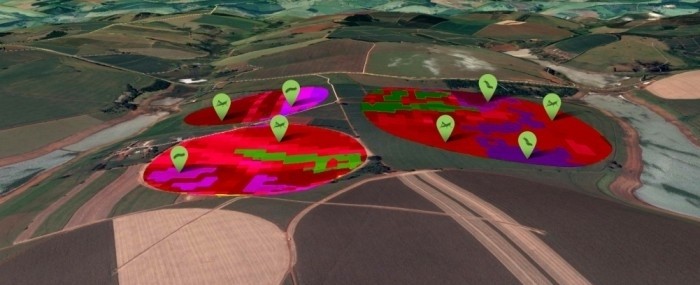
Artificial intelligence in integrated pest management
02 de janeiro de 2018By Suzel Tunes | FAPESP Research for Innovation – The losses suffered by Brazilian agriculture owing to crop pests and diseases amount to R$55 billion per year, according to data from the Brazilian Agricultural Research Corporation (EMBRAPA). Agrosmart, a digital agriculture company based in Campinas, São Paulo State, plans to change this situation using technology designed to run on the Internet of Things (IoT). It is developing an application that will be connected to pest traps to help farmers apply the right amount of agrochemical at the right time in order to combat pests more cost-effectively and with less environmental impact.
The project is one of eight selected in December 2017 after a call for proposals issued by the PIPE/PAPPE Grant Program, the result of an agreement between FAPESP and the Brazilian Innovation Agency (FINEP, a federal government body) to fund innovative research by small firms.
Led by agronomist Marcus Vinicius Sato, Agrosmart’s project is based on a set of techniques known as integrated pest management (IPM), developed in the 1960s to enhance the effectiveness and efficient of pest control by integrating an array of tools, such as chemical pesticides, biological agents (predators and bacteria, for example), light traps, and synthetic pheromones (chemical substances that can attract or repel insects, such as natural pheromones).
“The project entails IPM using artificial intelligence to identify and quantify insects,” Sato says. Pheromones will be used to attract insects to traps equipped with sensors and strategically distributed around the plantation. The sensors, connected to on-board electronic systems, will send the data they collect to the internet, where images will be processed and insects counted and identified. Depending on the number of insects per square meter, agrochemicals may or may not be used. The farmer will receive a ready-made report on these data via smartphone or tablet.
Sato says connection to the internet will be possible even in areas at a considerable distance from a major city, although this is one of the main challenges for the project. “Internet access in remote rural areas is very difficult. In some places, 3G doesn’t work even in the city center,” he acknowledges. “However, Agrosmart has surmounted this connectivity barrier with customized solutions for every region. If 3G isn’t available, we use satellite technology.”
Sato has a master’s degree in soil science from the University of São Paulo’s Luiz de Queiroz College of Agriculture (ESALQ-USP) in Brazil. He also interacts well with the firm’s information technology specialists: before earning his degree in agronomy at ESALQ, he took a technical course in mechatronics at Campinas Technical High School (COTUCA) maintained by the State University of Campinas (UNICAMP). “This training has been useful,” he says. “It’s helped me grasp the fundamentals of hardware development.”
Sato has been responsible for R&D at Agrosmart since 2015 and says the firm plans to apply for support from FAPESP for one of its projects. “We’ve chosen a product for which there are no domestic equivalents at present,” he explains. Smart traps produced abroad use machine learning technology to identify insects, but they cost too much for Brazilian farmers. “We want to develop a more affordable product,” he says.
Agrosmart is already testing prototypes, and the system is highly reliable, especially when well-established pheromones are used to attract the target insect. “So far, the worst error rate we’ve recorded is 5%,” Sato says. Different kinds of bait will also be tested. “Part of the project’s budget is for travel. We plan to test the system on the properties of farmers with whom we already have relationships in São Paulo State, southern Minas Gerais State, and also Mato Grosso do Sul and Rio Grande do Sul states,” he adds.
Agrosmart’s researchers expect to have the data validated and the app ready for sale within 18 months.
Partnerships with NASA and EMBRAPA
Agrosmart was founded in 2014 by three young entrepreneurs – Mariana Vasconcelos, Thales Nicoleti and Raphael Pizzi – and already has experience in digital agriculture, offering services that include crop monitoring with sensors capable of evaluating more than ten environmental variables.
Associated with ESALQ’s tech incubator since 2015, the firm was accelerated by Baita in Campinas. In 2016 it won the “Call to Innovation” water solutions competition organized in Brazil by the São Paulo IT & Management School (FIAP), and in the same year, it was invited by NASA to transfer technology in the area of satellite imaging.
In November 2017, Agrosmart began partnering with EMBRAPA to develop a system to automate crop disease diagnosis and monitoring. The project is part of a collaborative environment called “sitIoT” created by EMBRAPA to support the dissemination of digital agriculture. Agrosmart is the first startup to participate in the initiative.
The firm will install sensors on a coffee plantation used for experiments by EMBRAPA Environment in Jaguariúna, São Paulo State, to evaluate the effect of changes in atmospheric CO2 levels on coffee crops. The experiment is called FACE (Free Air CO2 Enrichment). Researchers at EMBRAPA have already observed adverse effects on coffee due to rising CO2 levels, such as intensification of coffee leaf rust (Hemileia vastatrix), one of the main diseases affecting the crop. The partnership aims to bring to market a technology capable of offering a model for the forecasting and control of crop diseases.
Company: Agrosmart
Site: agrosmart.com.br
Address: Av. José Rocha Bonfim, 214, Ed. Toronto, Sala 12, Campinas (SP) – Brazil
Tel: +55 19 3342-5387/+55 19 3203-7299
Contact: agrosmart.com.br/contato
